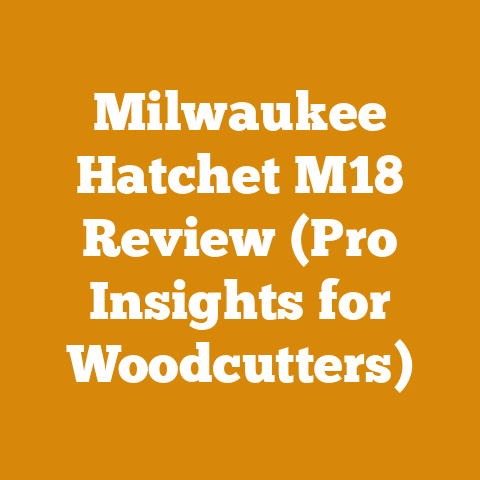Timber Frame Span Tables: Essential Sizing Guide (5 Pro Tips)
(Imagine a crisp autumn morning. The air smells of pine and freshly cut wood. Sunlight streams through the towering trees, illuminating a timber frame barn under construction. The massive beams, meticulously crafted and perfectly fitted, stand as a testament to the enduring strength and beauty of wood and the skill of those who work it.)
Timber Frame Span Tables: Essential Sizing Guide (5 Pro Tips)
Timber framing.
The very words conjure images of sturdy barns, elegant homes, and structures built to last generations.
But behind the beauty and longevity lies a critical element: proper sizing.
It’s not enough to just eyeball it.
Understanding span tables and applying sound engineering principles is crucial for a safe and structurally sound timber frame.
As someone who’s spent years knee-deep in sawdust, wrestling logs, and raising frames, I’ve learned a few things the hard way.
This guide isn’t just about reading tables; it’s about understanding the principles behind them, avoiding common pitfalls, and building with confidence.
Why Span Tables Matter: More Than Just Numbers
Think of a span table as your timber frame’s guardian angel.
It’s a chart that tells you the maximum distance a timber beam can safely span based on its size, material, and the load it will carry.
Ignoring these tables is like playing Russian roulette with gravity.
- Safety First: The primary reason to use span tables is to ensure the safety of the structure and its occupants.
Undersized timbers can lead to sagging, cracking, and even catastrophic failure. - Structural Integrity: Proper sizing ensures the frame can withstand the weight of the roof, walls, snow, wind, and everything else it’s designed to support.
- Cost Efficiency: Over-sizing timbers is a waste of material and money.
Span tables help you optimize your timber usage, saving you both time and resources.
I remember one project where a client insisted on using timbers that were significantly larger than necessary.
Not only did it drastically increase the cost, but it also made the frame unnecessarily heavy and difficult to work with. - Code Compliance: Building codes often require adherence to specific span table guidelines.
Failing to comply can result in fines, delays, and even the need to rebuild sections of your frame.
Understanding the Anatomy of a Span Table
Span tables can seem daunting at first glance, but once you understand the key components, they become invaluable tools.
Let’s break down the typical elements:
- Span (L): The distance between supports (e.g., posts) that the timber beam will bridge.
This is usually measured in feet or inches. - Timber Size (b x h): The dimensions of the timber beam, typically expressed as width (b) x height (h) in inches.
The height is the most important dimension for resisting bending. - Species and Grade: The type of wood (e.g., Douglas Fir, White Oak, Southern Yellow Pine) and its structural grade (e.g., Select Structural, No.
1, No.
2).
Each species and grade has different strength properties. - Load (W): The amount of weight the beam is expected to carry.
This is usually expressed in pounds per linear foot (PLF) or pounds per square foot (PSF).
There are two main types of loads:- Dead Load: The weight of the structure itself (e.g., roof sheathing, roofing materials, framing members).
- Live Load: The weight of temporary or variable loads (e.g., snow, wind, people, furniture).
- Deflection Limit: The maximum amount the beam is allowed to bend under load.
This is usually expressed as a fraction of the span (e.g., L/240, L/360).
A smaller deflection limit means a stiffer beam. - Bending Stress (fb): The maximum stress the wood fibers can withstand before bending excessively or failing.
This value is derived from engineering formulas and is specific to each wood species and grade. - Shear Stress (fv): The stress that occurs when one part of the beam tries to slide past another.
Shear stress is particularly important near the supports of the beam.
Example Table Snippet (Simplified):
Note: This is a highly simplified example.
Actual span tables are more complex and may include additional information.
Pro Tip #1: Wood Species and Grade – Know Your Lumber
Not all wood is created equal.
The species and grade of your timber have a dramatic impact on its strength and load-bearing capacity.
- Hardwoods vs.
Softwoods: Generally, hardwoods (e.g., Oak, Maple) are denser and stronger than softwoods (e.g., Pine, Fir).
However, some softwoods like Douglas Fir can be exceptionally strong for their weight. - Common Species in Timber Framing:
- Douglas Fir: A popular choice for its strength, straight grain, and availability.
It’s relatively easy to work with and takes fasteners well. - White Oak: Known for its exceptional strength, durability, and resistance to decay.
It’s often used in exposed locations or where high loads are expected. - Eastern White Pine: A softer wood that’s easy to work with and takes paint well.
It’s often used for non-structural elements like siding or trim. - Southern Yellow Pine: A strong and readily available softwood, but it can be prone to twisting and warping if not properly dried.
- Douglas Fir: A popular choice for its strength, straight grain, and availability.
- Grading Rules: Lumber is graded based on its appearance and structural properties.
Common grades include:- Select Structural: The highest grade, with minimal knots and defects.
- No.
1: A good grade for general construction, with some knots and defects allowed. - No.
2: A lower grade, with more knots and defects.
It’s generally not recommended for structural applications. - Stud Grade: Specifically graded for use in wall studs.
Data Point: Douglas Fir Select Structural has a bending stress (fb) of approximately 1,500 psi, while Eastern White Pine No.
2 has a bending stress of approximately 600 psi.
This means Douglas Fir can withstand more than twice the bending force of White Pine.
Personal Story: I once worked on a project where the client insisted on using locally sourced Eastern White Pine for all the structural timbers.
While I admired their commitment to sustainability, I had to explain that White Pine simply wasn’t strong enough for the intended spans and loads.
We eventually compromised by using Douglas Fir for the primary beams and White Pine for the secondary framing members.
Pro Tip #2: Calculating Loads – Don’t Underestimate
Accurately calculating the loads on your timbers is crucial for proper sizing.
Underestimating the load can lead to structural problems, while overestimating can result in unnecessary expense.
- Dead Load Calculation:
- Roofing Materials: Asphalt shingles, metal roofing, tile roofing – each has a different weight per square foot.
Consult manufacturer specifications for accurate figures. - Roof Sheathing: Plywood, OSB, or solid wood sheathing – again, each has a different weight.
- Framing Members: Rafters, purlins, collar ties – calculate the weight of these members based on their size, spacing, and species.
- Insulation: Rigid foam, fiberglass batts, spray foam – insulation can add significant weight, especially if it becomes saturated with moisture.
- Roofing Materials: Asphalt shingles, metal roofing, tile roofing – each has a different weight per square foot.
- Live Load Calculation:
- Snow Load: This is the most variable and often the most significant live load.
Consult local building codes for the required snow load for your area.
Snow load varies depending on geographic location, roof slope, and exposure. - Wind Load: Wind can exert significant pressure on a structure, especially on exposed walls and roofs.
Consult local building codes for the required wind load for your area. - Occupancy Load: The weight of people, furniture, and other contents of the building.
This is typically a smaller load than snow or wind, but it should still be considered.
- Snow Load: This is the most variable and often the most significant live load.
Example Calculation:
Let’s say you’re designing a timber frame roof in an area with a snow load of 30 PSF.
The roof is covered with asphalt shingles (3 PSF) and 1/2″ plywood sheathing (2 PSF).
The rafters are 2×8 Douglas Fir spaced 24″ on center (approximately 1.5 PSF).
- Total Dead Load: 3 PSF (shingles) + 2 PSF (sheathing) + 1.5 PSF (rafters) = 6.5 PSF
- Total Live Load: 30 PSF (snow)
- Total Load: 6.5 PSF (dead) + 30 PSF (live) = 36.5 PSF
You would then use this total load to consult a span table and determine the appropriate size for your roof beams.
Data Point: According to the ASCE 7 standard, minimum roof live loads can range from 20 PSF to 30 PSF depending on the building’s use and location.
Snow loads can range from 0 PSF in warm climates to over 100 PSF in mountainous regions.
Unique Insight: I’ve found that many people underestimate the weight of wet snow.
A foot of packed, wet snow can weigh upwards of 20 pounds per cubic foot.
This can significantly increase the load on your roof and should be factored into your calculations.
Pro Tip #3: Deflection Limits – Stiffness Matters
Deflection is the amount a beam bends under load.
While a certain amount of deflection is normal and acceptable, excessive deflection can be unsightly, cause damage to finishes, and even compromise the structural integrity of the frame.
- Common Deflection Limits:
- L/240: A relatively stiff deflection limit, often used for floors and roofs with brittle finishes (e.g., plaster, tile).
- L/360: A common deflection limit for roofs and floors.
- L/480: A more flexible deflection limit, often used for non-structural elements.
- Factors Affecting Deflection:
- Span: Longer spans will deflect more than shorter spans.
- Load: Heavier loads will cause more deflection.
- Timber Size: Larger timbers will deflect less than smaller timbers.
- Wood Species and Grade: Stronger woods will deflect less than weaker woods.
- Visual Impact of Deflection: Excessive deflection can cause ceilings to sag, doors and windows to stick, and floors to feel bouncy.
It can also lead to cracking in plaster or drywall finishes.
Example: A beam with a span of 12 feet (144 inches) and a deflection limit of L/360 can deflect a maximum of 0.4 inches (144 inches / 360 = 0.4 inches).
Case Study: I once worked on a timber frame house where the client wanted to use a very open floor plan with long spans.
I carefully calculated the required beam sizes to meet a deflection limit of L/360.
However, after the frame was erected, the client complained that the floor felt too bouncy.
After further investigation, I discovered that the client had added a heavy stone fireplace in the center of the span, significantly increasing the load.
We had to add additional support under the beam to reduce the deflection.
The lesson learned: always consider all potential loads when designing a timber frame.
Pro Tip #4: Moisture Content – Dry Wood is Strong Wood
The moisture content of wood has a significant impact on its strength and stability.
Wet wood is weaker and more prone to warping and decay than dry wood.
- Equilibrium Moisture Content (EMC): The moisture content at which wood neither gains nor loses moisture when exposed to a specific environment.
EMC varies depending on temperature and humidity. - Recommended Moisture Content for Timber Framing: Ideally, timber frame timbers should be dried to a moisture content of 12-15% before assembly.
This will minimize shrinkage and movement after the frame is erected. - Drying Methods:
- Air Drying: The traditional method of drying lumber by stacking it outdoors and allowing it to air dry.
This is a slow process, but it’s relatively inexpensive. - Kiln Drying: Drying lumber in a controlled environment using heat and humidity.
This is a faster and more reliable method than air drying.
- Air Drying: The traditional method of drying lumber by stacking it outdoors and allowing it to air dry.
- Measuring Moisture Content: A moisture meter is an essential tool for timber framers.
It allows you to quickly and accurately measure the moisture content of wood.
Data Point: The strength of wood decreases significantly as its moisture content increases.
For example, the bending strength of Douglas Fir at 20% moisture content is approximately 20% lower than its bending strength at 12% moisture content.
Practical Tip: When purchasing timber, ask the supplier for the moisture content of the wood.
If the moisture content is too high, allow the wood to dry further before using it in your frame.
I often use a combination of air drying and kiln drying to achieve the desired moisture content.
I’ll air dry the timbers for several months to reduce the initial moisture content, then finish them off in a kiln to ensure they’re properly dried.
Pro Tip #5: Local Building Codes – Know the Rules
Building codes are designed to protect public safety by ensuring that structures are built to meet certain minimum standards.
It’s essential to be familiar with the local building codes in your area before starting any timber frame project.
- Common Code Requirements:
- Span Tables: Building codes often specify which span tables are acceptable for use in your area.
- Load Calculations: Building codes may require you to submit detailed load calculations to demonstrate that your frame is adequately sized to withstand the expected loads.
- Connection Details: Building codes may specify the type and size of fasteners required for timber frame connections.
- Fire Resistance: Building codes may require you to use fire-resistant materials or construction techniques to protect the frame from fire damage.
- Working with Building Officials:
- Consult Early: Talk to your local building officials early in the design process to get their feedback on your plans.
- Be Prepared: Be prepared to answer questions about your design, load calculations, and construction methods.
- Be Flexible: Be willing to make changes to your design if necessary to comply with building codes.
Personal Experience: I once had a project where the building inspector rejected my initial plans because I hadn’t adequately addressed the wind load requirements.
I had to revise my design and add additional bracing to the frame to meet the code requirements.
It was a frustrating experience, but it ultimately resulted in a stronger and safer structure.
Actionable Advice: Don’t assume you know everything about building codes.
Attend local building code workshops, consult with experienced timber framers, and always double-check your plans with the local building officials.
Beyond the Tables: Engineering Judgement
While span tables are invaluable tools, they are not a substitute for sound engineering judgement.
Timber framing is a complex craft, and there are many factors that span tables don’t take into account.
- Complex Load Conditions: Span tables typically assume simple loading conditions, such as a uniformly distributed load.
In reality, loads can be concentrated or unevenly distributed. - Unusual Framing Geometry: Span tables may not be applicable to frames with unusual geometry or complex connections.
- Wood Defects: Span tables assume that the timber is free of significant defects.
In reality, all wood has some knots and other imperfections. - Environmental Factors: Span tables don’t account for environmental factors such as extreme temperatures, humidity, or exposure to corrosive chemicals.
When to Consult a Structural Engineer:
- Complex Designs: If your frame has complex geometry or unusual loading conditions, consult a structural engineer to ensure that it’s properly designed.
- Large Spans: If you’re using long spans, a structural engineer can help you optimize the timber sizes and connection details.
- Uncertainty: If you’re unsure about any aspect of your design, it’s always best to consult a structural engineer.
Final Thoughts:
Timber framing is a rewarding and challenging craft.
By understanding span tables, applying sound engineering principles, and working with experienced professionals, you can create beautiful and durable structures that will stand the test of time.
Remember, safety is paramount.
And always, always, double-check your work.
Happy framing!






